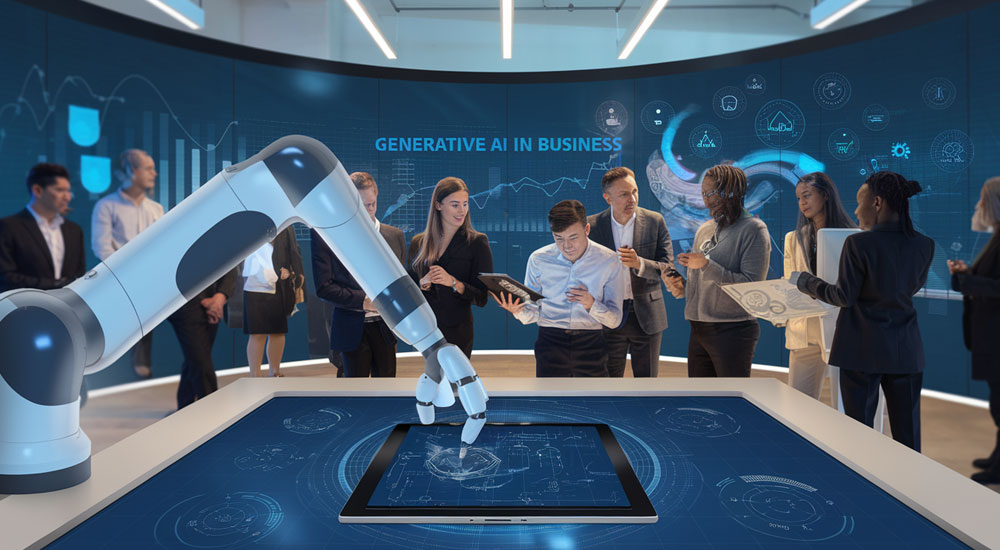Introduction

Imagine a world where every interaction with a brand feels like it was crafted just for you. 🎨✨ A world where businesses anticipate your needs before you even realize them, and products seem to magically align with your preferences. This isn’t a distant future – it’s the reality that Generative AI is ushering in right now.
In an era of information overload and fierce competition, personalization has become the holy grail of customer experience. But what if we told you that the current state of personalization is just scratching the surface? 🚀 Enter Generative AI – a game-changing technology that’s set to revolutionize how businesses tailor experiences for their customers. From creating bespoke product recommendations to crafting individualized marketing messages, Generative AI is taking personalization to unprecedented heights.
As we dive into the fascinating world of Generative AI and its impact on personalization, we’ll explore how this cutting-edge technology is transforming customer interactions, enhancing journey mapping, and revolutionizing marketing strategies. We’ll also tackle the challenges and considerations that come with this powerful tool, and provide insights on how businesses can implement Generative AI to create truly unforgettable customer experiences. Buckle up as we embark on a journey to discover how Generative AI is shaping the future of personalization! 🌟🔮
Understanding Generative AI in Customer Experience
Defining generative AI and its capabilities
Generative AI refers to artificial intelligence systems capable of creating new, original content based on patterns learned from existing data. In the context of customer experience, these systems can produce personalized content, recommendations, and interactions tailored to individual users. Some key capabilities include:
- Natural language generation
- Image and video synthesis
- Predictive analytics
- Adaptive learning
| Capability | Description | Example Application |
| Natural language generation | Creating human-like text | Personalized product descriptions |
| Image and video synthesis | Producing visual content | Custom product visualizations |
| Predictive analytics | Forecasting future behaviors | Anticipating customer needs |
| Adaptive learning | Improving over time | Refining personalization strategies |
How generative AI differs from traditional AI in personalization
Generative AI takes personalization to a new level compared to traditional AI approaches:
- Content creation: Generates unique content instead of selecting pre-existing options
- Adaptability: Continuously learns and evolves based on user interactions
- Contextual understanding: Considers complex factors for more nuanced personalization
- Scalability: Produces infinite variations for truly individualized experiences
Key technologies driving generative AI advancements
Several cutting-edge technologies are powering the rapid progress in generative AI:
- Deep learning neural networks
- Natural Language Processing (NLP)
- Computer vision
- Reinforcement learning
- Transformer models (e.g., GPT)
These technologies work together to enable generative AI systems to understand, create, and optimize personalized customer experiences with unprecedented accuracy and creativity. As these technologies continue to evolve, we can expect even more sophisticated and tailored interactions between businesses and their customers.
The Power of Hyper-Personalization
Moving beyond basic segmentation
Traditional customer segmentation methods are becoming obsolete in the face of hyper-personalization. Generative AI allows businesses to move beyond simple demographic or behavioral categories, creating dynamic, multi-dimensional customer profiles. These profiles evolve in real-time, considering a vast array of data points to provide truly individualized experiences.
| Traditional Segmentation | Hyper-Personalization |
| Static categories | Dynamic profiles |
| Limited data points | Vast array of data |
| Periodic updates | Real-time evolution |
| Broad targeting | Individualized approach |
Creating unique experiences for individual customers
Generative AI excels at crafting bespoke experiences for each customer. By analyzing historical data, current behavior, and predictive models, AI can:
- Generate personalized product recommendations
- Tailor content and messaging to individual preferences
- Create custom visuals and designs
- Adapt user interfaces to match user habits
Real-time adaptation to customer preferences
The power of hyper-personalization lies in its ability to adapt instantly. As customers interact with a brand:
- AI continuously analyzes behavior
- Preferences are updated in real-time
- Experiences are modified on-the-fly
- Each interaction becomes more relevant and engaging
Balancing personalization with privacy concerns
While hyper-personalization offers unprecedented opportunities, it also raises important privacy considerations. Businesses must:
- Implement robust data protection measures
- Provide transparency about data usage
- Offer opt-out options for customers
- Adhere to evolving privacy regulations
By striking the right balance, companies can leverage the power of hyper-personalization while maintaining customer trust and compliance with privacy standards.
Transforming Customer Interactions
AI-powered chatbots and virtual assistants
AI-powered chatbots and virtual assistants are revolutionizing customer interactions by providing personalized, real-time support. These intelligent systems can:
- Understand natural language and context
- Learn from previous interactions
- Provide instant, accurate responses
- Handle multiple queries simultaneously
| Feature | Traditional Chatbots | AI-Powered Assistants |
| Response Accuracy | Limited | High |
| Personalization | Basic | Advanced |
| Learning Capability | None | Continuous |
| Available Hours | Set times | 24/7 |
Personalized product recommendations
Generative AI enhances product recommendations by analyzing vast amounts of data to predict customer preferences with unprecedented accuracy. This leads to:
- Higher conversion rates
- Increased customer satisfaction
- Improved cross-selling and upselling opportunities
Tailored content creation and curation
AI-driven content personalization ensures that each customer receives relevant and engaging material. Benefits include:
- Customized email campaigns
- Dynamically generated website content
- Personalized social media feeds
Dynamic pricing strategies
Generative AI enables businesses to implement sophisticated dynamic pricing models that:
- Adjust prices in real-time based on demand
- Consider individual customer preferences and purchase history
- Optimize revenue while maintaining customer satisfaction
By leveraging these AI-powered strategies, businesses can create more meaningful and profitable customer relationships. As we move forward, we’ll explore how these transformative interactions contribute to enhancing the overall customer journey mapping process.
Enhancing Customer Journey Mapping
Predictive analytics for anticipating customer needs
Generative AI is revolutionizing customer journey mapping by leveraging predictive analytics to anticipate customer needs with unprecedented accuracy. By analyzing vast amounts of data, AI algorithms can identify patterns and trends that human analysts might miss, enabling businesses to proactively address customer requirements.
Here’s how predictive analytics enhances customer journey mapping:
- Behavior forecasting
- Personalized recommendations
- Churn prevention
- Demand prediction
| Feature | Benefit |
| Real-time data processing | Immediate insights for faster decision-making |
| Multi-dimensional analysis | Holistic understanding of customer behavior |
| Continuous learning | Improved accuracy over time |
Seamless omnichannel experiences
With generative AI, businesses can create cohesive customer experiences across multiple channels. This ensures that customers receive consistent, personalized interactions regardless of how they engage with the brand.
Key aspects of AI-driven omnichannel experiences:
- Dynamic content adaptation
- Cross-channel data synchronization
- Intelligent chatbots and virtual assistants
- Personalized product recommendations
Personalized touchpoints throughout the customer lifecycle
Generative AI enables businesses to deliver tailored experiences at every stage of the customer lifecycle. From initial awareness to post-purchase support, AI algorithms can create personalized content, offers, and interactions that resonate with individual customers.
Examples of personalized touchpoints:
- Customized onboarding processes
- Targeted email campaigns
- Personalized product usage tips
- Proactive customer support
By leveraging generative AI for customer journey mapping, businesses can create more engaging, relevant, and satisfying experiences that drive customer loyalty and lifetime value. As we move forward, we’ll explore how this technology is revolutionizing marketing and advertising strategies.
Revolutionizing Marketing and Advertising
AI-generated personalized ad content
Generative AI is transforming the landscape of marketing and advertising by creating highly personalized ad content. This technology analyzes vast amounts of customer data to generate tailored advertisements that resonate with individual preferences and behaviors.
Benefits of AI-generated personalized ad content:
- Increased relevance
- Higher engagement rates
- Improved conversion rates
- Cost-effective content creation
| Traditional Ads | AI-Generated Personalized Ads |
| Generic content | Tailored to individual preferences |
| One-size-fits-all approach | Dynamic and adaptive |
| Limited targeting | Precise audience segmentation |
| Static messaging | Real-time content optimization |
Scenario Analysis in FP&A: Predicting the Future of Your Business
In today's unpredictable business landscape, how can you prepare for the unexpected? 🤔 Imagine having a crystal ball that could reveal multiple futures for your company. Enter scenario analysis in FP&A – your secret weapon for predicting and shaping your business's destiny.
Optimizing ad placement and timing
AI algorithms excel at determining the optimal placement and timing for advertisements. By analyzing user behavior patterns, device usage, and browsing habits, generative AI can pinpoint the most effective moments to display ads for maximum impact.
Tailored email marketing campaigns
Generative AI revolutionizes email marketing by creating personalized content at scale. It can craft subject lines, body text, and calls-to-action that are tailored to each recipient’s interests and past interactions with the brand.
Personalized social media engagement
AI-driven personalization extends to social media platforms, where generative AI can create customized posts, comments, and responses. This technology enables brands to maintain consistent, relevant, and engaging conversations with their audience across various social channels.
Now that we’ve explored how generative AI is revolutionizing marketing and advertising, let’s look at some real-world examples of this technology in action.
Examples of Generative AI personalization in action
Real-Time Content Customization
Generative AI is revolutionizing real-time content customization, creating unique experiences for each user. For example, e-commerce platforms are using AI to generate personalized product descriptions based on a customer’s browsing history and preferences. This dynamic approach ensures that product information resonates with individual shoppers, increasing engagement and conversion rates.
AI-Powered Chatbots and Virtual Assistants
Advanced chatbots powered by generative AI are transforming customer service. These intelligent assistants can understand context, sentiment, and complex queries, providing highly personalized responses. For instance, a banking chatbot can offer tailored financial advice based on a customer’s transaction history and financial goals.
Personalized Video and Image Generation
| Application | Description | Benefits |
| Video Ads | AI-generated personalized video ads | Higher engagement, improved conversion rates |
| Product Images | Custom product visualizations | Enhanced shopping experience, reduced returns |
| Social Media Content | Tailored visual content for each user | Increased user interaction, stronger brand loyalty |
Generative AI is being used to create personalized videos and images at scale. For example, a travel company might use AI to generate customized vacation videos featuring destinations that align with a customer’s preferences and past travel history.
Adaptive Learning Platforms
In the education sector, generative AI is powering adaptive learning platforms that tailor educational content to each student’s learning style, pace, and knowledge gaps. These platforms can generate personalized quizzes, explanations, and study materials, ensuring a more effective and engaging learning experience.
Challenges and Considerations
Ethical implications of AI-driven personalization
AI-driven personalization raises significant ethical concerns that businesses must address:
- Transparency: Customers should be aware of AI’s role in their experiences
- Consent: Explicit permission for data usage and personalization
- Fairness: Ensuring equitable treatment across all customer segments
- Manipulation: Avoiding exploitative practices that take advantage of user vulnerabilities
| Ethical Concern | Impact | Mitigation Strategy |
| Lack of transparency | Erodes trust | Clear communication about AI usage |
| Absence of consent | Violates privacy rights | Opt-in policies and easy opt-out options |
| Unfair treatment | Discriminates against certain groups | Regular audits of AI algorithms |
| Manipulative practices | Exploits user weaknesses | Ethical guidelines for AI implementation |
Data privacy and security concerns
With the increasing use of AI for personalization, data protection becomes paramount:
- Robust encryption methods for data storage and transmission
- Regular security audits and vulnerability assessments
- Compliance with data protection regulations (e.g., GDPR, CCPA)
- Implementing data minimization principles
Overcoming algorithmic bias
Algorithmic bias can lead to unfair or discriminatory outcomes. To address this:
- Diverse training data: Ensure representation of all customer segments
- Regular bias testing: Implement ongoing checks for biased outputs
- Human oversight: Incorporate human review in decision-making processes
- Continuous learning: Update algorithms to correct identified biases
Balancing automation with human touch
While AI enhances personalization, maintaining a human element is crucial:
- Identify key touchpoints where human interaction adds value
- Train staff to work alongside AI systems effectively
- Provide options for customers to choose between AI and human assistance
- Use AI to augment human capabilities rather than replace them entirely
Now that we’ve explored the challenges and considerations, let’s look at how businesses can effectively implement Generative AI for personalization.
Implementing Generative AI for Personalization
Assessing organizational readiness
Before implementing Generative AI for personalization, it’s crucial to evaluate your organization’s readiness. This assessment involves examining several key factors:
- Data infrastructure
- Technical capabilities
- Cultural readiness
- Ethical considerations
| Factor | Description | Importance |
| Data infrastructure | Quality and quantity of customer data | High |
| Technical capabilities | Existing AI/ML expertise and tools | Medium |
| Cultural readiness | Openness to AI-driven decisions | High |
| Ethical considerations | Privacy and bias awareness | Critical |
Choosing the right AI solutions
Selecting the appropriate Generative AI solutions is critical for successful implementation. Consider the following:
- Alignment with business goals
- Scalability and flexibility
- Integration capabilities with existing systems
- Vendor expertise and support
Training and upskilling teams
To maximize the benefits of Generative AI, organizations must invest in their workforce:
- Develop AI literacy programs for all employees
- Provide specialized training for data scientists and engineers
- Foster a culture of continuous learning and adaptation
Measuring success and ROI
Tracking the impact of Generative AI implementation is essential for justifying investments and guiding future strategies. Key metrics to consider include:
- Customer satisfaction scores
- Conversion rates
- Average order value
- Customer lifetime value
- Return on marketing investment
By focusing on these areas, organizations can effectively implement Generative AI for personalization, revolutionizing their customer experiences and gaining a competitive edge in the market.
Conclusion
Generative AI is poised to revolutionize personalization in customer experiences, offering unprecedented opportunities for businesses to tailor their interactions, marketing, and services to individual preferences. By leveraging advanced algorithms and vast amounts of data, companies can create hyper-personalized experiences that enhance customer satisfaction, loyalty, and engagement. From transforming customer interactions to revolutionizing marketing strategies, the potential applications of generative AI in personalization are vast and exciting.
As businesses look to implement generative AI for personalization, it’s crucial to address challenges such as data privacy, ethical considerations, and maintaining a human touch. By carefully navigating these issues and embracing the power of generative AI, companies can create truly remarkable, personalized experiences that set them apart in an increasingly competitive marketplace. The future of customer experiences lies in the hands of those who can harness the potential of generative AI while prioritizing customer needs and values.
FAQs on Generative AI and the Future of Personalization
Generative AI refers to artificial intelligence systems that can create new content, such as text, images, or audio, based on patterns learned from existing data. In personalization, it enhances customer experiences by:
- Analyzing vast amounts of customer data
- Identifying unique patterns and preferences
- Creating tailored content and recommendations
- Adapting in real-time to customer interactions
| Aspect | Traditional Personalization | Generative AI Personalization |
| Data Processing | Limited to predefined rules | Analyzes complex patterns |
| Content Creation | Uses existing content | Creates new, unique content |
| Adaptability | Static or slow to update | Real-time adaptation |
| Scalability | Limited by manual input | Highly scalable |
- Privacy concerns: Handling sensitive customer data
- Algorithmic bias: Potential for unfair or discriminatory outcomes
- Over-personalization: Risk of creating "filter bubbles"
- Transparency issues: Difficulty in explaining AI-driven decisions
- Assess current personalization strategies
- Identify suitable use cases for Generative AI
- Invest in robust data infrastructure
- Partner with AI solution providers
- Develop ethical guidelines for AI use
- Train staff on AI capabilities and limitations










